Denim has been a cornerstone of global fashion for over a century — timeless, durable, and effortlessly cool. Yet, behind the classic blue jeans lies a staggering environmental cost. Traditional denim production consumes thousands of liters of water per pair, along with toxic dyes and chemicals that pollute rivers and ecosystems.
In response, the industry is undergoing a sustainability revolution led by waterless denim innovations — new technologies and materials that drastically reduce water use, minimize waste, and eliminate harmful chemicals.
This movement isn’t just reshaping how jeans are made; it’s redefining what responsible fashion looks like in the 21st century.
Why Waterless Denim Matters
Conventional denim manufacturing is notoriously water-intensive. From cotton cultivation to dyeing and finishing, producing a single pair of jeans can use anywhere from 1,500 to 10,000 liters of water. Most of that water is used in washing, bleaching, and indigo dyeing — processes that traditionally rely on large amounts of water and energy.
Waterless denim technology addresses this issue through innovation, precision, and eco-conscious design. By drastically cutting down water usage, these techniques not only protect freshwater resources but also reduce chemical runoff, carbon emissions, and production costs.
Table: Traditional vs. Waterless Denim Production
| Process Stage | Traditional Denim | Waterless Denim Innovations | Water Savings |
|---|---|---|---|
| Dyeing | Indigo vats using synthetic chemicals and large water baths | Foam dyeing, laser finishing, and air dyeing technologies | Up to 90% less water |
| Finishing | Multiple wet washes and bleaching | Ozone and enzyme treatments | 70–100% less water |
| Cotton Sourcing | Conventional cotton requiring heavy irrigation | Organic, regenerative, or recycled cotton | Up to 80% less water in cultivation |
| Energy Use | High due to water heating and washing | Reduced through dry processes | 60% less energy consumption |
Key Waterless Denim Technologies
1. Foam Dyeing
One of the most groundbreaking innovations in denim production is foam dyeing. Instead of submerging yarn in indigo dye baths, manufacturers apply dye through foam — a method that uses virtually no water.
This process, pioneered by companies like Wrangler and Indigo Mill Designs, also eliminates the need for multiple rinse cycles, reducing chemical waste and energy consumption. The result is vibrant, long-lasting color with a fraction of the environmental footprint.
2. Ozone Finishing
Ozone finishing is a dry process that uses ozone gas to fade or distress denim without traditional bleach or water-based treatments. Ozone naturally breaks down dyes and brightens fabric while sanitizing it.
Not only does this method conserve water, but it also reduces chemical use and processing time. The air used in the ozone system is continually recycled, making it a closed-loop, sustainable technology.
3. Laser Distressing
Traditional denim distressing — the process of creating whiskers, fades, and worn-in textures — relies on water-heavy stone washing and hand sanding. Laser technology replaces these methods with precision light beams that etch patterns directly onto the fabric.
This fully dry process eliminates the need for pumice stones and chemical sprays, improving worker safety and consistency while cutting water use by up to 80%.
4. Enzyme and Nanobubble Finishing
Instead of washing jeans multiple times with harsh chemicals, enzyme treatments use natural biological agents to achieve softness and faded effects.
Meanwhile, nanobubble technology introduces microscopic air bubbles into the washing process, which help distribute chemicals evenly without needing large water volumes. Both innovations can reduce water usage by more than 90%, making denim production cleaner and more efficient.
5. Recycled and Regenerative Cotton
While finishing technologies play a major role, true water savings start with the raw material. Recycled cotton and regeneratively farmed cotton use far less water than conventional cotton. Recycled fibers give new life to post-consumer waste, while regenerative farming restores soil health and improves water retention.
Brands incorporating these fibers are addressing sustainability from the ground up — quite literally.
Leading Brands Pioneering Waterless Denim
Levi’s Water<Less Collection
Levi’s, a denim pioneer, has saved over 4 billion liters of water through its Water<Less process. By combining techniques like ozone finishing and water recycling, the brand produces jeans that maintain classic quality while dramatically reducing environmental impact.
Wrangler Indigood Foam Dyeing
Wrangler’s Indigood line uses foam dyeing technology, eliminating nearly all water from the dyeing process. The innovation has set a new benchmark for large-scale sustainable denim manufacturing.
G-Star RAW and Jeanologia
G-Star RAW has partnered with Jeanologia, a technology company that develops laser and ozone systems for denim finishing. Together, they’ve created collections that are 100% waterless, chemical-free, and energy-efficient.
Environmental Impact and Benefits
The shift to waterless denim offers multiple environmental and social benefits:
- Massive Water Savings: Reducing up to 95% of water per pair of jeans.
- Reduced Chemical Pollution: Eliminates bleach, acids, and toxic dyes.
- Lower Carbon Emissions: Energy-efficient dry processes cut CO₂ output.
- Worker Safety: Replacing hazardous manual treatments with safe, automated systems.
- Consumer Awareness: Promotes eco-conscious shopping and brand accountability.
These innovations prove that sustainability and style can coexist — and that the fashion industry can reduce its impact without sacrificing quality or creativity.
The Human Side of Sustainable Denim
While the technology behind waterless denim is remarkable, its implications go beyond the environment. By minimizing harmful chemicals and improving working conditions, these innovations promote ethical labor practices and healthier manufacturing environments.
There’s also a growing connection between sustainability and well-being. Just as Fashion and Mental Health intersect in conversations about self-expression and mindfulness, sustainable denim represents a shift toward conscious consumption — choosing products that align with personal and planetary values.
Consumers increasingly see eco-friendly fashion as a reflection of inner harmony and responsibility, blending aesthetics with awareness.
Challenges in Scaling Waterless Denim
Despite rapid progress, the industry faces challenges in making waterless denim mainstream:
- High Initial Investment: Advanced technologies like lasers and ozone machines require capital.
- Infrastructure Limitations: Smaller manufacturers may lack access to modern machinery.
- Consumer Education: Many shoppers still associate sustainable denim with higher costs.
- Material Compatibility: Not all fabrics respond the same to dry processes.
As innovation becomes more accessible, economies of scale and government incentives are expected to drive broader adoption.
Table: Benefits of Waterless Denim Technologies
| Benefit | Impact |
|---|---|
| Water Conservation | Saves up to 95% of water used in traditional denim manufacturing |
| Reduced Chemicals | Eliminates bleach and toxic dyes |
| Worker Safety | Minimizes exposure to harmful substances |
| Lower Carbon Footprint | Less energy and fewer emissions |
| Product Consistency | Automated systems improve quality and precision |
FAQs About Waterless Denim
Q1: What makes denim “waterless”?
Waterless denim refers to jeans produced using technologies that significantly reduce or eliminate water consumption during dyeing and finishing processes.
Q2: Are waterless jeans more expensive?
Initially, yes — but as technology scales, prices are becoming more competitive, making sustainable denim more accessible to consumers.
Q3: Does waterless denim feel different?
Not at all. In fact, advanced dyeing and finishing methods often enhance softness, color depth, and durability.
Q4: Can I tell if my jeans are waterless?
Brands usually label water-saving collections or include sustainability certifications on tags and websites.
Q5: How can consumers support waterless denim?
By choosing brands that prioritize sustainable manufacturing, buying fewer but better-quality jeans, and supporting circular fashion initiatives.
The Future of Waterless Denim
The denim industry stands at the edge of a new era — one defined by circularity, transparency, and innovation. As waterless technologies continue to evolve, they’ll not only conserve billions of liters of water but also inspire a new generation of eco-conscious consumers and designers.
From foam dyeing to laser finishing, these solutions demonstrate that true style never has to come at the planet’s expense. By embracing sustainability at every level — from fiber to finish — denim is finally shedding its environmental baggage and moving toward a cleaner, smarter, and more mindful future.
Waterless denim isn’t just a trend; it’s the blueprint for fashion’s sustainable transformation — where technology, creativity, and conscience come together to protect the planet and redefine the meaning of blue jeans.







